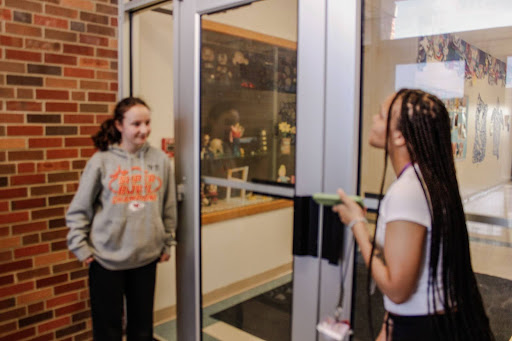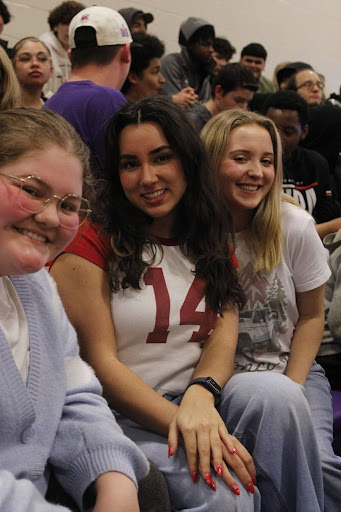Teaching During COVID-19: An Inside Look From a Teacher’s Perspective
Learning during COVID-19 has been hard for everyone. Hear what Hickman teachers have to say about what teaching is like right now.

This school year has been a rough one for everyone, not just students; Hickman teachers are struggling, too. The teachers are trying hard to make this year possible. They care about students and want to see them succeed. “This year, getting ready for this school year was harder than my first year of teaching,” said Physics teacher Mr. Willenberg. “That says a lot because first year teaching is crazy.”
When asked one thing the teachers wanted their students to know, it was simple: “I want students to know that their teachers have absolute empathy for them. The stress that you guys are feeling is equal to the stress that we’re feeling. When you guys feel like you’re going to have a breakdown, we do too,” said Ms. Everett-Kennedy, lovingly referred to as EK by her students, a sophomore English teacher.
AP Statistics teacher Ms. Gonzalez concurred with EK. “Just know that we want to be at school too. I became a teacher to interact with my students. My favorite part is getting to know kids.”
“I don’t feel as connected to my students,” Willenberg said. “I’m having a hard time developing that relationship. It’s hard to develop this relationship, this student-teacher relationship where they develop a sense of trust in me. It’s really, really hard to do that in this virtual environment.” All the teachers echoed this message. The lack of student-teacher relationships has been hard. Everett-Kennedy noted, “the biggest and most important thing is the ability to form relationships with… students.”
The lack of participation in class has certainly taken a toll, and teachers can only guess it is because students aren’t as talkative over a screen. One teacher noted that while in class, students can’t always see every face in the room when they talk, not all eyes are on them. In zoom, not only can students see their own face, but they feel afraid to speak knowing all eyes are on them. “Students are a little more hesitant to vocalize responses or ask questions in this setting,” US History Teacher Mr. Devero said.
Devero spoke for all four teachers when he said: “To be honest, I think every component of this [teaching online] has been challenging to some extent.” Devero has noticed that like EK, participation in his classes has gone down severely since school has been online. “Depending on the class, I don’t get a large percentage of my class actually popping into zoom and participating in that manner.”
Teachers want their students to know what it’s like from their perspective. When asked if she thought her students understood what it’s like from her perspective, Gonzalez said, “I think some of them might… but 99% of them, no, I do not think they understand.” Gonzalez does believe that her students are trying their best to give her grace, just as she extends grace towards them.
Devero agrees, his students have been really good about extending grace towards him. “I think students have been really awesome about that. About taking into consideration, that they’re empathizing. They know we don’t like this, we know they don’t like it, and I think there’s a camaraderie built around willing to adapt and work with one another so that we can get something out of this,” he said.
These teachers spoke to the intense amount of work they are putting in to make their classes work virtually. EK mentioned that she has almost no time outside of school for her personal life. “I used to be able to go home and have family time and I don’t now,” she said. “I haven’t read a book in gosh knows how long. I’m an English teacher, I love reading. I haven’t read since school started.”
Teachers are putting in a lot of work behind the scenes to make life easier for their students. “I really don’t think outside of teachers anybody really realizes the amount of work that we are having to put in to do this,” Willenberg said. “I spent ten, eleven, twelve hours between Saturday and Sunday getting the lessons for this week for one class done.”
“Honestly, I feel like I am always checking my email, even when I’m not at school,” Gonzalez said. “I’m emailing at 9:00 pm while I’m at a volleyball game coaching.”
Every teacher wishes that their students would engage with the material, and they especially wish students would turn their cameras on. Devero said: “I would love if students would turn their cameras on when we zoom.” EK and Gonzalez concurred. While teachers wish their students turned their cameras on, they are empathetic to kids who don’t like having their camera on. None of the interviewed teachers require students to show their face, but they always request that if possible, students do.
This year, because many students keep their cameras off, it is hard for teachers to know who needs help.“The biggest challenge is being able to see, and read students,” Gonzalez said. “Lots of times, when you’re teaching a lesson, you can look out at the crowd, and even if kids aren’t asking questions, you can gauge by their face whether they need help or not.”
EK agreed. “If I were in the classroom, I could see you, and I’d be like, ‘that cupcake [student] needs my help.’”
Willenberg said: “I haven’t been able to build rapport with the students. It’s hard to do that this way.”
Despite how difficult teaching online is, teachers have also found certain things to be of benefit to their students. “The things I think are doing better, there are some things we’re doing in NearPod that I think are really helpful,” EK said. She noted that while some things have been really difficult, some new things are working better for her students than the normal in-seat learning. “I think the way I taught active reading this year was better than how I’ve taught it in years past.”
Gonzalez added: “I do like that I’m getting to see my students every day.”
Willenberg had a similar thought: “I think this is an advantage for some kids. They’re able to learn at a little bit more of their own pace. If they need, you know, two or three days to work on this one item, well they have it now in this environment. I think in a positive sense, this has benefited some kids.”
The teachers of Hickman are giving their best to make this school year count. They want patience and grace and understanding from their students. Willenberg put it well: “Just grace, know that we’re going to stumble a lot along the way. We give grace to students. Just be flexible, be a little patient with us, with all of us, because we’re having to navigate a new world of doing this.”





